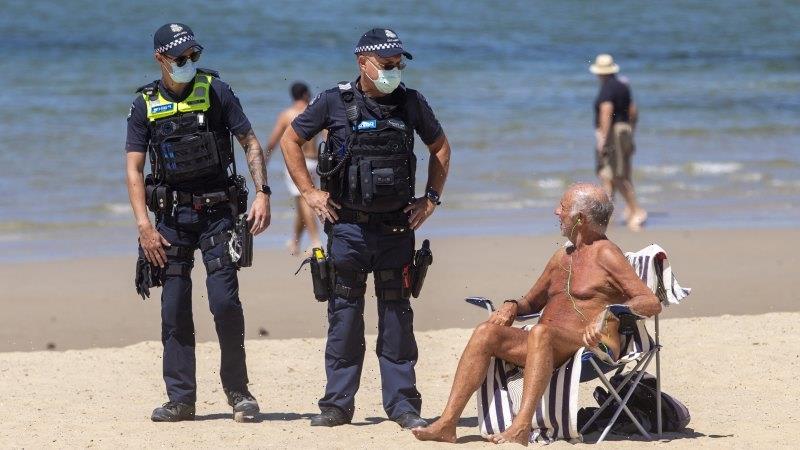
Let’s not repeat the same mistakes with COVID response
August 10, 2022Australia’s relative success in keeping COVID case numbers down during the first two years of the pandemic, largely thanks to extremely strict national and state border closures other jurisdictions eschewed due to their impact on human rights, masked how confused and, at times, unhinged from reality our policy response actually was – and remains.
One of the enduring memories of Australia’s COVID response is how intensely policed public spaces were during lockdowns. Photographs of crowds gathering on beaches on sunny days went viral as Australians dobbed on each other for being outside. Mounted police patrolled iconic foreshore areas, issuing people with fines and move-on notices.
Police ask people to leave St Kilda beach during one of Melbourne’s lockdowns. Credit:Wayne Taylor
In Victoria, the policing of public spaces reached particular heights of absurdity, first with the edict that face masks could be removed in public for the consumption of all food and drink, except alcohol, and then with the specific shutdown of outdoor playgrounds.
Australia, despite the myths we tell about ourselves, is a rule-loving nation, with a deep respect for authority and an antipathy to social liberalism. COVID or no COVID, we love stopping people coming into “our” country, people who live near beaches have always hated “outsiders” taking up space, and we regularly ban public drinking.
So, the fact that many of these measures were also popular throughout the first couple of years of the pandemic, as panic and fear of catching COVID swept through the population, isn’t surprising. But popularity isn’t the measure upon which public health measures should be judged.
At the very beginning of the pandemic, when there was a high degree of uncertainty about how COVID spread, we were all focused on wiping down surfaces and “deep cleans”. But by 2021, the World Health Organisation had acknowledged that COVID was spread in the air.
Australian governments were also reaching similar conclusions, after numerous hotel quarantine breakouts and the rapid spread of the virus in high-density, poorly ventilated settings like public housing blocks. But none of that new evidence seemed to translate into updated policy measures.
During lockdowns outdoor activity was restricted to a couple of hours a day, even when that was the safest place to be. Basketball nets were chained up, police ushered children away from skate parks and playgrounds were taped off. Meanwhile, the virus continue to spread, disproportionately impacting essential workers who tended to live in higher density, often overcrowded housing.
Why the disconnect? It’s much easier to convince the public you’re taking things seriously with a visible police presence and high-impact policies like patrolling beaches and parks, regardless of their efficacy. Restructuring the economy and the way we live in order to minimise transmission is more complicated, more expensive and harder to communicate.
For that reason, it was somewhat refreshing to see Victoria’s Chief Health Officer Brett Sutton, the architect of some of the above bizarre arrangements, acknowledge the importance of getting people outdoors to limit COVID transmission. I say somewhat because during the period when Sutton reigned supreme, before having his wings clipped by the state government, limiting transmission was orders of magnitude more important than it is now – and a focus on ventilation and getting people outdoors, rather than fining them for sitting in a park with a friend – would have made a tremendous difference.
Victorian Chief Health Officer Brett Sutton.Credit:Simon Schluter
The big difference between then and now is vaccinations. Vaccines haven’t made COVID disappear, but they have done the job they were designed to do: massively reduce the risk of serious illness and death. For a brief period, the advent of vaccines united Australian policymakers. When the vaccination rate reached a certain point, lockdowns would end. The goal, in a vaccinated world, was no longer to end transmission but to inoculate the community from the worst of the virus.
But vaccination rates have stalled. Barely half the population has had three doses, while only 16 per cent have had a fourth jab. A lack of urgency and complicated messaging about eligibility has no doubt contributed to the slowdown. And, as Sutton’s recent intervention demonstrates, confusion about what we’re trying to achieve has set back in. Sutton said that ventilation was “on par” with increasing vaccination uptake in terms of limiting the impacts of COVID.
If the goal is reducing transmission than he might be right, but that hasn’t been a goal of any state or federal government since lockdowns ended. There remains a small rump of academics who vocally argue that zero-transmission should be the goal, but in an era of vaccines it’s now a fringe view.
The problem we now have is that not enough people understand the importance of booster doses, or are confused about whether they can access them. Litigating debates about ventilation and airflow would’ve been invaluable last year but, while they remain important, vaccination is still the key to keeping us safe.
Two years of counter-productive messaging on where the risks of COVID really lie have done a lot of damage. Let’s not repeat the same mistakes now when we know what works.
The Morning Edition newsletter is our guide to the day’s most important and interesting stories, analysis and insights. Sign up here.
Most Viewed in National
From our partners
Source: Read Full Article




